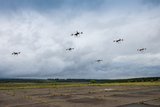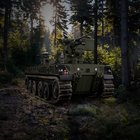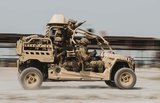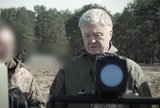Fire Scout operates across the US
Across the United States, the Navy's Fire Scout Vertical Take-Off and Landing Tactical Unmanned Aerial Vehicle took the skies, operating in four different locations ashore and afloat, Nov.18.
Over the course of one day, teams from the Navy and industry partner Northrop Grumman tested the aircraft at Webster Field, Md., Yuma Proving Ground, Ariz., aboard the USS Halyburton (FFG-40) off the coast of Jacksonville, Fla. and USS Freedom (LCS 1) at the sea range in Point Mugu, Calif.
"Flying in four locations in one day, off two classes of ships which includes our newest [LCS], marks a major milestone for our program and for Naval Aviation," said Rear Adm. Bill Shannon, Program Executive Officer for Unmanned Aviation and Strike Weapons. "This success highlights the phenomenal efforts of the entire Fire Scout team, and sets the stage for the introduction of a game-changing capability to our warfighters."
Operations began in the morning at Webster Field when the Navy/industry team conducted a functional check flight. A FCF is a routine part of the test program to determine whether the system is functioning according to established standards.
As the Fire Scout completed its flight at Webster Field, a major milestone was achieved as the unmanned helicopter took off for the first time from the Navy's Freedom class of Littoral Combat Ships. The team conducted phase one of dynamic interface testing aboard the USS Freedom, which defines the launch and recovery wind envelope aboard the ship. This is a critical step to integrating the Fire Scout on both variants of LCS.
Back on the East Coast, a pilot proficiency flight took off from the USS Halyburton. In preparation for the Fire Scout's deployment aboard the frigate early next year, newly trained operators from the Helicopter Anti-Submarine Squadron Light 42 (HSL-42) were able to get additional flight time during this operation.
"Our goal during flight tests is not only to ensure the system operates efficiently, but we also want to ensure all personnel are highly trained and qualified to operate the system when deployed, said Capt. Tim Dunigan, Fire Scout program manager. "The operators are key to successful missions."
The culmination of the day's flights ended in Yuma when a team from Northrop Grumman conducted vibration monitoring system testing. The purpose of this testing is to mature fleet procedures to perform track and balance of the rotor system.
"Extensively testing the system and monitoring its performance, makes us confident that Fire Scout will provide critical situational awareness, intelligence, surveillance, reconnaissance and targeting data to the warfighter," according to Dunigan.
Recently the Fire Scout surpassed more than 1000 flight hours since test program began in December 2006. The program is managed by the Navy and Marine Corps Multi-Mission Tactical Unmanned Systems program office (PMA-266), which is also responsible for the emerging area of Air Launched UAS.
The Fire Scout has two deployments scheduled for 2011. The system will support Intelligence, Surveillance and Reconnaissance missions aboard the USS Halyburton in the Mediterranean Sea and Horn of Africa and ground-based operations in Central Command.
Source: NAVAIR
More from Uncrewed Vehicles
-
![Ready for the race: Air separation drone swarms vs. air defence systems]()
Ready for the race: Air separation drone swarms vs. air defence systems
As the dynamics of aerial combat rapidly evolve, Chinese scientists have engineered a sophisticated air separation drone model that can fragment into up to six drones, each capable of executing distinct battlefield roles and challenging the efficacy of current anti-drone defences such as the UK’s Dragonfire laser system.
-
![Israel’s MALE UAVs ‘must adapt’ to Iranian-made air defences]()
Israel’s MALE UAVs ‘must adapt’ to Iranian-made air defences
Advancements in air defence technologies have begun to reshape aerial combat dynamics in the Middle East, as illustrated by recent events involving the Israeli Air Force and Hezbollah.
-
![Hundreds more UAS sent to Ukraine forces with thousands more on the way]()
Hundreds more UAS sent to Ukraine forces with thousands more on the way
Both sides of the Russia-Ukraine war have been using UAS for effective low-cost attacks, as well as impactful web and social media footage. Thousands more have now been committed to Ukrainian forces.
-
![AI and software companies selected for US Army Robotic Combat Vehicle subsystems]()
AI and software companies selected for US Army Robotic Combat Vehicle subsystems
The US Army has intentions to develop light, medium and heavy variants of the Robotic Combat Vehicle (RCV) as part of the branche’s Next Generation Combat Vehicle family.
-
![DroneShield to improve software of DroneSentry-X C-UAS system under new contract]()
DroneShield to improve software of DroneSentry-X C-UAS system under new contract
DroneSentry-X, a cross-vehicle compatible, automated 360° C-UAS detect and defeat device, can offer 360° awareness and protection using integrated sensors. According to its manufacturer, it is suitable for mobile operations, on-site surveillance and on-the-move missions.
-
![Ukraine takes delivery of new indigenous C-UAS systems]()
Ukraine takes delivery of new indigenous C-UAS systems
Funded by the country’s former president, the new C-UAS systems will be sent to the frontline where they have already been tested against Russian invading forces.


























